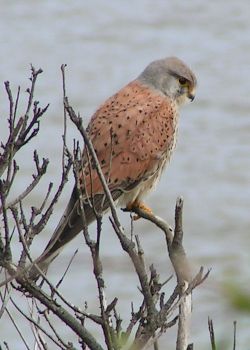Kestrel
2007 Schools Wikipedia Selection. Related subjects: Birds
| iKestrel | ||||||||||||
|---|---|---|---|---|---|---|---|---|---|---|---|---|
 Adult male Common Kestrel
|
||||||||||||
| Scientific classification | ||||||||||||
|
||||||||||||
|
|
||||||||||||
|
See text. |
The name kestrel is given to several different members of the falcon genus, Falco. Kestrels are most easily distinguished by their typical hunting behaviour which is to hover at a height of around 10–20 m over open country and swoop down on prey, usually small mammals, lizards or large insects. Other falcons are more adapted to active hunting on the wing.
Kestrels require a slight headwind in order to hover, hence a local name of windhover for Common Kestrel. Their ability to spot prey is enhanced by being able to see ultraviolet which is strongly reflected by vole urine.
Plumage typically differs between male and female, and (as is usual with monogamous raptors) the female is slightly larger than the male. This allows a pair to fill different feeding niches over their home range. Kestrels are bold and have adapted well to human encroachment, nesting in buildings and hunting by major roads.
Kestrels do not build their own nests, but use nests built by other species.
Bird species known by this name include:
- The Common Kestrel, found in Europe, Asia, and Africa
- The smaller Lesser Kestrel, found in southern Europe, India, and Mediterranean Africa
- The American Kestrel, found in North America and South America
- The Fox Kestrel, found in Equatorial Africa
- The Gray Kestrel, found in Central to Southern Africa
- Dickinson's Kestrel, found in Eastern to Southern Africa
- The Greater Kestrel, found in Eastern to South Africa
- The Madagascar Kestrel
- The Banded Kestrel, found on Madagascar
- The Seychelles Kestrel
- The Mauritius Kestrel
- The Spotted Kestrel, found in Indonesia
- The Nankeen Kestrel, found in Australia and New Guinea